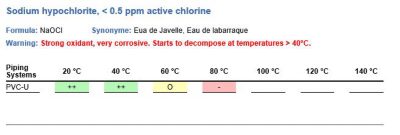Chemical Resistance
Plastic pipes have a very good chemical resistance and often offer a far more reliable, and long-term solution than traditional metallic pipe systems for the transport of chemicals.
Plastic pipes are used not only for drinking water, water for general use and wastewater, but also for transporting chemically aggressive liquids and gases. Therefore, questions regarding the chemical resistance of piping materials to media are as important as the mechanical parameters for the installation of the piping system. Today expensive pipe designs, such as lined metal, ceramic or glass fiber reinforced pipes can be replaced by plastic systems in many cases. GF Piping Systems attempts to present resistance statements in order to identify the best suitable material for your application. The recommendations given in the ChemRes PLUS database are not only based upon the long and extensive applicational experience of GF but origin as well from tests in GF-own laboratories. The data are subject to frequent updating and addition. ChemRes PLUS is an easy way to obtain information on the chemical resistance of materials used in products from GF Piping Systems. It’s very straightforward to use:
- Select the medium to be transported
- Select the pressure/temperature point corresponding to your application
- ChemRes PLUS shows you the suitable materials in a clear table
Thanks to decades of experience, our specialist teams are highly knowledgeable about the chemical resistance of materials. The online tool ChemRes PLUS provides you with key basic data for each individual materials resistance to a range of chemicals.



